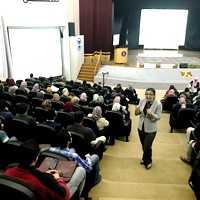
This workshop is available to be delivered face-to-face or virtually.
Research needs to be published in the appropriate journals to reach the right audience, and be communicated clearly to have impact in the field. Help your early- and mid-career researchers achieve these goals by hosting a ‘Getting Published’ workshop with Nature Research Academies.
“Great seminar by a real professional who really knows publishing. He explained in detail the important matters for publication. I liked how he provided editor‘s perspectives… One of the most meaningful workshops.”
A 1-day workshop includes your choice of 3-4 modules, while the 2-day workshop includes all 7 modules. If you would like to place special attention on some modules, we can extend modules or create a 1-day agenda devoted to a particular module.
This module does not focus on grammar, but rather how to clearly communicate your ideas in English. Therefore, it is suitable for all levels of English proficiency. In the first section, we discuss three cognitive learning principles: cognitive load theory, cognitive bias, and reader expectations. The section gives advice on how to keep sentences concise, avoid ambiguity, and use logical sentence structure to improve reader understanding. The second section focuses on improving readability, such as through active voice and appropriate word choice, to better engage readers. Lastly, we cover some common writing mistakes, as well as appropriate verb tense for manuscripts.
This module covers how to logically structure your manuscript. We begin by discussing strategies to make the writing process more efficient and then review the importance of the Introduction. For social science attendees, this section also includes how to write a clear Literature Review. We look at how to write the methodology to validate the study design and how to clearly present the findings in the figures, tables, graphs, and equations (dependent on the field of the attendees). For physical sciences attendees, we also review combined Results–Discussion sections. Lastly, we discuss how to convey the impact of the study in the Discussion section and how to write a strong conclusion..
“I’ll definitely teach my students today’s topics. I particularly liked ‘Manuscript Structure’ the most because I can share this easily with my students to improve their papers.”
Clearly communicating your complex data to your readers is necessary to establish their validity and support the conclusions of your study. Therefore, this module will provide insightful tips and strategies to ensure that authors choose the most appropriate presentation and display their data accurately. We will first begin by covering ethical principles that authors should be aware of when presenting their data as well as figure guidelines used by many journals. We then review graphs and tables to present numerical information, including when to use each and if using graphs, which ones would be most appropriate. We move on to discuss presenting photographic and line art images, emphasizing clarity, representativeness, and accuracy. We then conclude this module with tips on writing clear figure captions that factually describe the complex information shown in the figure.
This module discusses how to improve the chances that your paper will be downloaded and read by others in your field. We begin by discussing how to write a title that clearly describes what your paper is about and helps it to stand out. We then review the importance of keywords and using search engine optimization to improve the visibility of articles. Lastly, we focus on how to write effective abstracts that summarize what you have done. We also discuss how to write structured, unstructured, and graphical abstracts.
This module discusses how to determine the most appropriate target audience. We then review strategies on how to identify the best journal, as well as how to improve the suitability of the manuscript for a particular journal. Lastly, we highlight what journal editors are looking for when evaluating submitted manuscripts, and how to communicate the significance and relevance of the study to the journal editor in your cover letter.
This module covers what reviewers are evaluating, how to interpret the journal editor’s decision letter, and strategies for next steps upon receiving the decision letter. We will then look at how to write an effective response letter with point-by-point responses to all the reviewer comments. Lastly, we will discuss how to promote your article after publication, as well as strategies to consider if your manuscript is rejected.
This module covers important issues related to ethical conduct in both research and writing. We first discuss acceptable and unacceptable modifications of your images. Then, we cover what qualifies someone to be an author on your paper and ethical issues surrounding conflicts of interest, as well as how to properly submit and/or divide your study into multiple papers. We will then cover plagiarism and how to properly paraphrase. Lastly, we will discuss the importance of transparency in reporting and sharing all the results from your study.